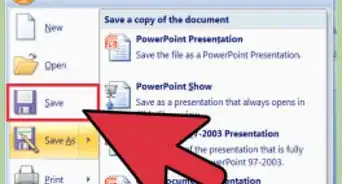This article was co-authored by Maureen Taylor. Maureen Taylor is the CEO and Founder of SNP Communications, a leadership communications company based in the San Francisco Bay Area. She has been helping leaders, founders, and innovators in all sectors hone their messaging and delivery for almost 30 years, and has worked with leaders and teams at Google, Facebook, Airbnb, SAP, Salesforce, and Spotify.
There are 7 references cited in this article, which can be found at the bottom of the page.
wikiHow marks an article as reader-approved once it receives enough positive feedback. This article received 19 testimonials and 89% of readers who voted found it helpful, earning it our reader-approved status.
This article has been viewed 569,528 times.
Delivering presentations is an everyday art form that anyone can master. To capture your audience's attention, present your information with ease and confidence. Act as if you are in a conversation with your audience, and they will pay attention to you. To get this level of fluency, write an engaging narrative, use more visuals than text in your slides, and practice, practice, practice.
Steps
Rehearsing Your Presentation
-
1Give it the "bar" test. The "bar" test ensures that your idea is clear and your storytelling is effective. Before you write your presentation, make notes sketching out your message. Think of it as a story, with a beginning, middle, and end. Then ask a colleague or friend who knows nothing about your project to listen to your summary.[1]
- Deliver your summary to them in friendly, direct language, as if you were telling the story to a friend in a bar.
- In fact, you can tell the story to a friend in a bar. However, telling a colleague over coffee can work just as well.
- Get them to tell you what their takeaway was. If they can summarize your message accurately, that's a good sign.
-
2Practice your speech in front of a colleague while you're still developing it. Find a friend, colleague, or mentor who you trust to give you useful feedback. Rather than waiting until your presentation is "finished," deliver it to them while it's still a draft. That way, they can give you tips not just on your delivery, but on the organization of your content as well.[2]
- Ask them to be your coach.
- Give them your presentation once or twice and let them ask you questions and give feedback.
- Ask them to point out moments that are dull or confusing.
Advertisement -
3Prepare for nerves. It's important to rehearse in front of people because it will make you less nervous when the time comes. If you tend to get nervous when you give presentations, you can go further during your rehearsals in order to reduce your nerves.[3]
- Write down what you're afraid of. What exactly worries you when you give a speech? Looking foolish? Being asked a hard question? Write down your exact fears, and then consider them each individually.
- Think about what you will do in each situation. For instance, if your fear is, "I'll forget what I'm saying," you can prepare a plan like, "If I forget what I'm saying, I'll pause, scan my notes, and find the next important point I need to make."
- Catch your negative thoughts, and calm them. If you think, "I'm going to get nervous and sweaty," replace it with, "I have important information to deliver and everyone is going to pay attention to that."
-
4Time yourself carefully. You don't want to go over your time frame and get cut off, or wear on the patience of your audience. Time your rehearsals, especially those you give in front of others, to see that you are staying within the time you have.[4]
- Give yourself extra time if you plan to take questions, or if you anticipate lots of digressions.
-
5Practice repeatedly. Try practicing in front of your dog, your mirror, or your family. Practice speaking with an engaging tone. Gesture and emote as if you were addressing your audience. Know your presentation backward and forward.[5]
- This doesn't mean sticking to a strict script every time. Instead, when you rehearse, improvise freely. Deliver your main points, but include quips and anecdotes that occur to you as you go. You'll remember the best ones when you actually deliver the presentation.
Delivering Your Presentation with Confidence
-
1Fake confidence. It's totally fine to feel nervous, but you don't have to act that way. The more confident you act, the more confident you will feel. This doesn't mean that you need to act arrogant. Try to calm yourself and remind yourself that what you're doing isn't unusual. Rather, it's necessary, interesting, and ordinary.[6]
- Remind yourself that your audience likely can't see your nerves.
- Take a deep breath and exhale before you go on stage.
-
2Show your emotion. Smile, raise your eyebrows, and otherwise tell your story through feelings as well as facts. Show your audience your own passion for the topic. Say everything as if you find it interesting and expect them to be interested by it as well. Your enthusiasm will be infectious.[7]
-
3Speak to your audience. The more directly you address your audience, the more engaged they will feel. Be relaxed and conversational. Rather than rattling off your points, deliver them to the audience as if you are certain they will be interesting. Look directly into the faces of the people you are addressing.[8]
- If there are too many people to really see faces, just look boldly into the crowd.
-
4Mind your body language. Stand up straight and face the audience completely. Keep your head up and your shoulders back and relaxed. Don't twist any part of your body (shoulders, hips) away from the audience.[9]
- Move your hands as you speak. Don't wave them, as this will make you look nervous. Instead, try calmly gesturing with your palm out when you make a point. If you describe a shape, draw it in the air with your hands.
Crafting a Compelling Presentation
-
1Think of your presentation as a story. As you write, instead of organizing your presentation by topics and subtopics, organize it along a story arc. Start by setting the stage, then pull your audience into a tale with an exciting climax. It may help to start your presentation with a question or a dilemma so they feel involved from the start.[10]
- Have a clear through line that runs through all parts of your presentation, leading to your main point.
- Include stories that put your listeners into a situation. Get their energy with tactile details (sound, sight, smell, taste, touch) and descriptions of an emotional state.
- Include moments of reflection in which you share how you felt or feel.
-
2Make your slides are visual as possible. Avoid bullet points that explain everything you are going to say. Instead, present charts, graphs, photos, or illustrations that only you can explain. This way, your audience remains focused on you.[11]
-
3Call special attention to key points. Before you deliver something you want the audience to pay attention to, alert them of this. If you can, make your audience feel as if they have a stake in whether or not they get your point. Say something like, "now this is where we lose a lot of people" or, "this is one of the parts that's the most difficult to explain."[12]
-
4Include humor. Make jokes and tell funny anecdotes. Try leading your audience up to a point that sounds as if it will be serious, technical, or even dangerous, and then surprise them with a joke. If your presentation has a lot of data, you might transition between topics with funny visuals.
- As always with humor in a work setting, remember that humor varies widely between cultures. Avoid making any jokes that make fun of anybody's sex, gender, race, class, or ability. Remember to "punch up"—if your jokes take someone on, take on someone with more power than you, rather than less.
- If you get nervous, try starting your presentation with a simple joke or a funny story. It will put you and your audience at ease.
-
5Find ways to make your presentation interactive. If you are working with a small crowd, you can talk directly to members of the audience. Ask someone to tell a joke to get you warmed up, or quiz audience members about their experience with something related to your topic. If it's a large group, ask questions that each audience member can answer with a show of hands. Take votes, or polls.
- Ask the crowd to consider something or imagine something, and hold a moment of quiet while they do.
- Interactive moments make great pivots from one section of your talk to another.
-
6Consider your audience. Write a presentation that will help you effectively communicate with the audience you have. Ask yourself:
- Will these be experts, or newcomers to your ideas? If they're experts, you'll need to present them with specific, technical, and new ideas. If they're newcomers, plan to introduce them more generally to your topic, and avoid technical terms.
- Will audience members be on your side from the start, or will they need persuading?
- Will you have a large, faceless crowd, or a small group? If you're working with a small group, you can include them in parts of your presentation through questions, personal digressions, and conversations.
Expert Q&A
-
QuestionWhat are some effective presentation techniques?
 Maureen TaylorMaureen Taylor is the CEO and Founder of SNP Communications, a leadership communications company based in the San Francisco Bay Area. She has been helping leaders, founders, and innovators in all sectors hone their messaging and delivery for almost 30 years, and has worked with leaders and teams at Google, Facebook, Airbnb, SAP, Salesforce, and Spotify.
Maureen TaylorMaureen Taylor is the CEO and Founder of SNP Communications, a leadership communications company based in the San Francisco Bay Area. She has been helping leaders, founders, and innovators in all sectors hone their messaging and delivery for almost 30 years, and has worked with leaders and teams at Google, Facebook, Airbnb, SAP, Salesforce, and Spotify.
Public Speaking Expert Project your voice. You might even feel like you're screaming. However, volume makes you enunciate your words better and it brings out inflection. You can easily sound bored if you're quiet. Bring the volume up, and you'll bring up your inflection too.
Project your voice. You might even feel like you're screaming. However, volume makes you enunciate your words better and it brings out inflection. You can easily sound bored if you're quiet. Bring the volume up, and you'll bring up your inflection too. -
QuestionAt what point can I say, "Over to you"?
 Community AnswerIf you're presenting with another person, and you've finished one section of your topic, you can say, "Over to you."
Community AnswerIf you're presenting with another person, and you've finished one section of your topic, you can say, "Over to you." -
QuestionHow do I make an effective presentation?
 Community AnswerUse a slide show, and if you can't do this, print out and give your audience handouts. Be sure to include pictures and graphs, or even a video, to maintain their attention!
Community AnswerUse a slide show, and if you can't do this, print out and give your audience handouts. Be sure to include pictures and graphs, or even a video, to maintain their attention!
References
- ↑ http://firstround.com/review/This-Advice-From-IDEOs-Nicole-Kahn-Will-Transform-the-Way-You-Give-Presentations/
- ↑ https://www.student.unsw.edu.au/rehearse-your-presentation
- ↑ https://www.comm.pitt.edu/speech-anxiety
- ↑ https://www.student.unsw.edu.au/rehearse-your-presentation
- ↑ http://firstround.com/review/This-Advice-From-IDEOs-Nicole-Kahn-Will-Transform-the-Way-You-Give-Presentations/
- ↑ https://www.unr.edu/writing-speaking-center/student-resources/writing-speaking-resources/speech-anxiety
- ↑ https://www.student.unsw.edu.au/speaking-audience
- ↑ https://www.student.unsw.edu.au/speaking-audience
- ↑ https://www.toastmasters.org/resources/public-speaking-tips/gestures-and-body-language
- ↑ http://firstround.com/review/This-Advice-From-IDEOs-Nicole-Kahn-Will-Transform-the-Way-You-Give-Presentations/
- ↑ http://firstround.com/review/This-Advice-From-IDEOs-Nicole-Kahn-Will-Transform-the-Way-You-Give-Presentations/
- ↑ http://firstround.com/review/This-Advice-From-IDEOs-Nicole-Kahn-Will-Transform-the-Way-You-Give-Presentations/
About This Article
If you're worried about delivering an effective presentation, go over your notes again and make sure your presentation is telling a story with a distinct beginning, middle, and end. This type of structure will make it easier for people to follow along, and when you finish your presentation, they'll be more likely to remember what it was about! If you're still unsure, try practicing in front of other people before the big day. By rehearsing your presentation in advance, you'll not only feel more comfortable when you present it in front of an audience, but you can also get helpful feedback from your peers to make your presentation even better. Alternatively, if you're feeling a little nervous, identify what exactly you're afraid of happening during your presentation, and then come up with a plan for each scenario so you're less stressed about it. For example, if you're worried about forgetting what to say next, you could make a list of all the important points you need to make and have it with you during your presentation. For tips from our Communications co-author, like how to appear confident during a presentation, keep reading!














































































